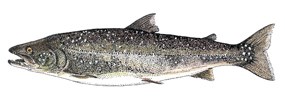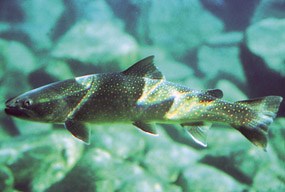
Bull Trout - Salvelinus confluentus Identification: 
Spawning: Native to the State of Washington, bull trout are found in a number of the rivers within, and surrounding, the park. There are populations in the Queets, Quinault, Hoh, Elwha, Dungeness and North Fork Skokomish Rivers. In late fall, from October to December, bull trout can be spotted in the North Fork Skokomish River which runs down to the lower-eastern corner of the park, in the Staircase area. Bull trout require very cold water for spawning and migrate further upstream than most other species. Conservation Status: The Puget Sound population is considered threatened, based on low abundance and loss of critical freshwater habitat. Because of their complex habitat requirements, such as woody debris, boulders, and undercut banks, even marginal structural or flow changes make bull trout suseptible to decline. Over-fishing, and competitive displacement by non-native species (particularly brook trout) has also proved detrimental to the population. Bull trout were thought to inhabit the majority of the Elwha River watershed before the Elwha dam was built in 1910. After dam removal, natural recolonization is expected as upstream and downstream passage is reestablished. Both the landlocked populations above the dams and the anadromous bull trout below the dams are expected to contribute to recolonization of the Elwha. (Historic Range Map) Protection and restoration of bull trout habitat is included in the National Oceanic and Atmospheric Administration's Puget Sound Salmon Recovery Plan. Publications:
|
Last updated: April 24, 2025

